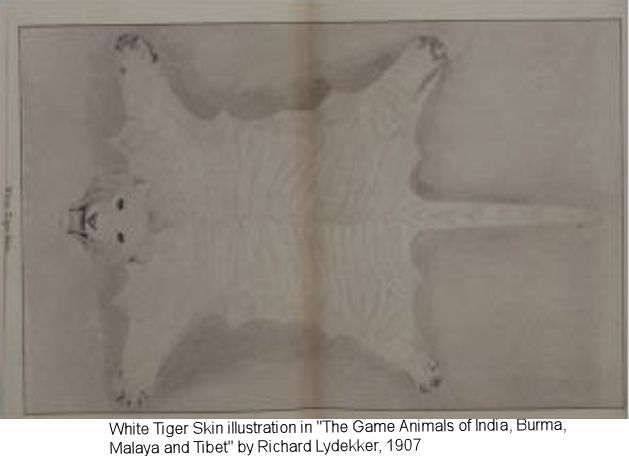
|
WHITE TIGERS 1900 TO 1950s |
Historical quotations are credited and are in the public domain. Original text is licensed under the GFDL. I am grateful to Paul McCarthy and Jerry Blackman for researching and providing extensive material, information and corrections on white tigers and for genealogies.
“White gene” vs “Inhibitor gene.”
Although these pages refer to “white genes,” white tigers have the genes for normal orange colours, but those genes are switched off by a recessive “inhibitor gene.” When a tiger inherits 2 copies of the inhibitor gene, the normal orange colour is suppressed. In general parlance, it’s simply easier to refer to “white genes.”
A WHITE TIGER - Indian Daily News, 1st May, 1902: Information reaches us from a reliable source that a white tiger is prowling in the jungles between Nanjangud and Gundalpet. It would appear that the animal was hitherto subsisting on jungle hogs, but now it is destroying cattle in the villages. As the animal is a rare specimen in the forest of Mysore, the Government will we hope capture the brute and keep it in the Zoo. It is also stated that there are more remarkable specimens of jungle tribes in some parts of the Gundulpet forests, - specimens, which it would be worth while to capture for preservation. - Mysore Standard.
WHITE TIGERS: Madras Weekly Mail, 23rd July 1908 - “F. K. K.” writes to the Pioneer:- In your paper of the 4th instant I see “C. A.,” with reference to white, or freak tigers (by the way, is the term Albino applicable?), asks your readers how many skins are in existence in India or out of it. Well, besides the one he refers to, I know of only two others, and these were bagged in the Lakhimpar District, U. Assam, either in 1899 or 1900 – I forget which precisely. These differed from the one he describes in the matter of the markings, for these were of a very light cream ground with stripes of a slightly darker shade of the same colour, and these stripes could only be seen in a certain light when the skin or eye was held in a slanting position. In this way is unique with the black stripes, I should say, and must look sufficiently weird. Perhaps the manner in which the first white tiger I ever heard of, or anybody else for the matter of that, was shot may be of some interest to your readers. Two old and intrepid shikaris, tea garden managers of the district, had been out after buffalo on elephants and, on getting out of the tall grass, elected to go on foot. They had not gone far when M. picked up some white hair which he declared to the very incredulous G., his companion, to be tiger’s adding that the owner and a boar had engaged in mortal combat. So sure was he of this that he took up the trail - more white hair, blodd, etc. There was the boar lying dead all right as he expected, and not many yards off a white tiger slinking into some grass, looking very sick. G. got a hurried shot, and only managed to graze the brute, as he thought. However, the carcase was found two days afterwards by Assamese not far from the spot the tiger had been fired at, but, no doubt, the mauling from the boar had gone a very long way towards its death. The skin, minus a lot of hair, was roughly cured and sent down to the Curator of the Calcutta Museum, as a curiosity for inspection and report. Our friends, the planters, did not quite realise what a curiosity it was till they had entered into a lengthy correspondence with the Curator over its recovery. Anyhow, they found it a devil's own job before that worthy would part, and they got back their own - or rather its equivalent, some £100 in hard cash.
The second skin was got far more easily. A couple of months afterwards a hawk-eyed young planter spotted some Assamese carrying something white slung on a pole on the way to the Jaipur Cachari from the verandah of his bungalow - an upstairs verandah. Landing on the ground below in an incredibly short time, he closed with the Assamese to take over for Rs. 60, just double of the Government reward. Needless to say this was another white tiger, no doubt a brother or sister of the one first short. This skin, marked in the same way, was sold in England for £100, so that very likely there are at present only two white skins in India, that is, if the one that fell into the Calcutta Museum Curators hands was kept in Calcutta. Perhaps others of your readers may be in a position to account for a few more white tigers of their skins, as also the reason for this strange discoloration of hair - this chameleon-like proclivity.
In Harmsworth Natural History (1910, chief contributors R Lydekker, Sir H Johnston & Prof JR Ainsworth-Davis) p372: “As rare exceptions, both white and black tigers are met with. A white tiger, in which the fur was of a creamy tint, with the usual stripes faintly visible in certain parts, was exhibited in the menagerie at Exeter ‘Change in London about 1820; a second example was obtained at Poona about 1902, and a third in Assam in the spring of 1899. All three specimens were of a beautiful creamy white colour, with faint indications of stripes.” Lydekker (1907) doubted the existence of true albino tigers, but old records of Cooch Behar mention a tawny tigress who was shot along with 2 coloured and 2 sickly-looking white cubs that had extended necks and pink eyes.

The Journal of the Bombay Natural History Society (JBNHS) published "Miscellaneous Notes: A White Tigress in Orissa" in JBNHS Vol XIX, Pt 3, 28 Feb 1910: In the "Indian Forester" for May, Mr Bavis Singh, Forest Officer, Dhenkanal, Orissa, records the shooting of a white tigress in the Mulin Sub-Division Forest of the Dhenkanal State, Orissa. He describes the colour of the animal as follows:- "The ground colour was pure white and the stripes were of a deep reddish black colour." The tigress was shot over a buffalo kill and was in good condition not showing any signs of disease. There are several previous records of white tigers. In "Wild Sports of Burma and Assam," Col FT Pollock writes:- "Occasionally white tigers are met with. I saw a magnificent skin of one at Edwin Wards in Wimpole Street, and Mr Shadwall, Assistant Commissioner in Cossyah and Jynteah hills, also had two skins quite white."
Writing in 1907 Mr Lydekker in the "Game Animals of India" mentions five white tiger skins as follows:- "A white tiger was exhibited alive at Exeter Change about 1820[a much repeated error!]; a second was killed at Poona about 1882; in March 1899 a white tiger was shot in Upper Assam and the skin sent to Calcutta, where a fourth specimen was received at about the same time. The Maharaja of Koch-Behar also possesses a white tiger-skin."
This is also described in the Aberdeen Press and Journal, 1st June 1909: White Tigress Shot, in Bengal. A white tigress, 8 feet 8 inches in length, has been shot in Dhenkanal, says the Lucknow correspondent of the 'Standard." The ground colour was pure white, and the stripes were a deep reddish black colour. The skin has been presented the Rajah of Dhenekanal who has had it mounted and placed in his palace. The shikaris (hunters of this country) say that it is the only white tiger they have seen.
The Journal of the Bombay Natural History Society (JBNHS) published an article “An Albino Tiger From The Central Provinces” in volume XIX. The following letter was printed in the JBNHS, Vol XXIV, Pt IV, page 819. An Albino Tiger From The Central Provinces: I have just had the opportunity of examining the skin of an albino tiger from the Central Provinces; it was killed about six years ago in the Pendra Zamindari of the Bilaspur District. This skin with the paws cut away is piped with green flannel and mounted with the head raised and the mouth open. It measured from nose to tail 7 feet 6 inches, of which the tail only measured 2 feet 6 inches, but this has probably been shortened by the dresser as it was not intact near the root. The narrowest part across the skin measured 2 feet 8 inches. It was cream coloured throughout but paler on the head and the stripes were chocolate brown. The fur was rather long and soft in texture; its whiskers, of which only three remained were dark-brown and white. It is still in fairly good condition except for a few small bare patches on the face and behind the ears. The animal had been shot by an uncle of the owner (Syed Anwar Padsha, Revenue Inspector, Seoni Chhapara, C. P.) who brought it to the museum with a hope of disposing of it and my object of putting this in the journal is merely to put the fact on record and to give any would-be purchasers of such curiosities an opportunity.
E A D’Abreu, Fellow of the Zoological Society, Central Museum, Nagpur, 1st May 1916
Editor’s Note: In Volume XIX of this Journal a white tiger was recorded from Orissa and the other occurrences on record were also given.
The earliest known photograph of a live white tiger comes from the JBNHS, from pg. 932 from No. 4, Vol. XXVII (1921) about the white tiger captured by the Maharaja of Rewa in 1915. The article was published in 1921 although the tiger died in 1920. An earlier photo of a white tiger in the JBNHS is of one shot around 1910 as part of the article "An Albino Tiger From The Central Provinces" and is briefly referred to in this later article.
MISCELLANEOUS NOTES : No. 1.—A WHITE TIGER IN CAPTIVITY (with a photo.)
We publish the photograph of a White Tiger which is at present in captivity in the Maharaja’s gardens at Rewa. The photo was forwarded to the Society through the agency of Capt. K. Evans Gordon. Mr. Janki Prasad, Home Member, Council of Regency, Rewa, when sending the photo, supplied Capt. Evans Gordon with the following details.
“The white tiger in captivity in Rewa was caught in December 1915 in the jungles of the State near Sohagpur. He was about two years of age at the time. There were two more white tigers at the time in Southern Rewa related to this tiger but it was believed that the mother of this animal was not white. A big cage was kept for months in the jungle in which live pigs were placed to attract the tiger. The Shikaries concealed themselves on a tree above the cage and by a contrivance, a sort of door could be let down as soon as the tiger was inside. The tiger was accordingly caught when inside the cage killing the pig. A white tiger was killed by a Sardar in Sohagpur Tahasil, Southern Rewa, about 10 or 12 years ago. Two other tigers appeared in the beat near the Shabdol and Annuppur, B. N. Ry., but His late Highness’ orders were that these should not be shot. The one at Annuppur (Bhilam Dungari Jungle) was said to be brother of the white tiger in captivity. These white tigers roam in the neighbouring British Districts of the Central Provinces and seem to be living in the Maikal ranges of mountains.”
|
|
|
Mr. H. E. Scott of the Indian Police has very kindly furnished us with the following description and notes in connection with the animal.
Description.. (From examination of tiger on December 3rd, 1920.)
Body Colour - Pure white. No cream colour was visible. The ‘Creamy-white’ as described by Mr. Janki Prasad was probably due to the dirt of the cage. (The tiger is now better cared for than formerly.)
Stripes - Indistinct or light black, not brown as stated by Mr. Janki Prasad. While some of the stripes, particularly the face markings, are quite black, the majority are ash-coloured owing to white hairs being mixed with the black. In the hot weather, the hair, as is the case with all felines, goes a lighter colour, and the black stripes take on a slightly brownish tinge, but this is never pronounced.
Nose - . Mottled grey-pink (instead of pure pink as in normal tigers).
Lips - . Grey-black on hair-line but quickly merge to pink (instead of being quite black and gradually merging
to pink well inside the mouth as in normal tigers).
Eyes- The colourings of the eyes are very indistinct. There is no well-defined division between the yellow of the comex and the blue of the iris. The eyes in some lights are practically colourless merely showing the black pupil on a light yellow back ground.
Eyelids - Pinkish-black.
Ears - . Practically normal in colour and markings. The ground black is however slightly ashy.
General description and Discussion regarding identity - The tiger is of course underdeveloped owing to years of captivity, but in height he is probably slightly above normal and in a wild state would undoubtedly have been an exceptionally large animal.
To that miscellaneous note, the Journal editors added the following:-
I, myself, when stationed in Bilaspur District in. 1919, did my best in the hot weather to come up with a white tiger, which must have been a very large and heavy animal, judging from the size of the pug-marks which I tracked on many occasions. This tiger was however very shy and would not look at tied ‘kills’ but was especially fond of bison cows and calves. He was constantly seen by herdsmen in the jungle, but never made an attempt to take an animal out of the herd. The above would seem to indicate that these white tigers run large, which suggests a theory that they are not mere albinos but a distinct variety of Felis tigris. These white tigers have been known for years in the neighbourhood where the Bilaspur and Mandla. Districts of the C. P. join with Rewa. State. One was shot by a villager in the north of Bilaspur District, about 15 years ago, and another in the Rewa State some years later. There are at present to my knowledge three white tigers in the jungle and it is quite probable that there are many more, as the area in Maikal Hills, which they in. habit is large, wild, and hilly, and, since the beating for or killing of tigers is prohibited in the State, it is possible that these shy white tigers might roam in this secluded jungle for years undetected and unmolested Last year in the hot weather two of these white tigers, full grown, were seen taking a sand bath in the bed of a stream in the South of this State. They may of course have been born of the same mother but the observed constant association of white tigers with one another tempts one to believe that they do not interbreed with the ordinary variety of tiger.
White tigers are mentioned in the book “Tiger for Breakfast” by John Burroughs (1921). It is a short note appended to an account of an albino leopard shot in Behar, in a forest neighboring the town of Sassaram. Various theories have been advanced to explain this freak white leopard. If white leopards were believed to be almost nonexistent until Boris's specimen was shot, a certain number of white tigers have been found, and the Maharaja of Rewa has now managed to breed a white tiger which has sired cubs like its father, pure white with dark stripes and blue eyes. Boris believes that the coloration of white tigers and leopards is due to the presence of certain minerals in the soil. Nearly all white tigers that have been captured or shot were found in the vicinity where Boris bagged his leopard, in Bchar around Takari, Rewah and Sarguja, a geographical area with formations of limestone. It is believed that this mineral or some other in the water or the salt licks may be responsible for the pigmentation of these freaks. (This would have been the 1915 white tiger captured by Maharajah Gulab Singh of Rewa.)
A A Dunbar Brander, F.Z.S., F.R.G.S. Conservator of forests, wrote in his book Wild Animals In Central India (1923): "White tigers occasionally occur. There is a regular breed of these animals in the neighbourhood of Amarkantak at the the junction of the Rewa state and the Mandla and Bilaspur districts. When I was last in Mandla in 1919, a white tigress and two three parts grown white cubs existed. In 1915 a male was trapped by the Rewa state and kept in confinement. An excellent description of this animal by Mr. Scott of the Indian police, has been published in Vol. XXVII, No. 47, of the Bombay Natural History Society's journal." He added "As one often sees mounted specimens with pink insides to their mouths, it may be as well to mention that the insides of tigers' mouths are a light whitish olive green, and the tongues are yellowish white or grey but faintly tinged with pink."
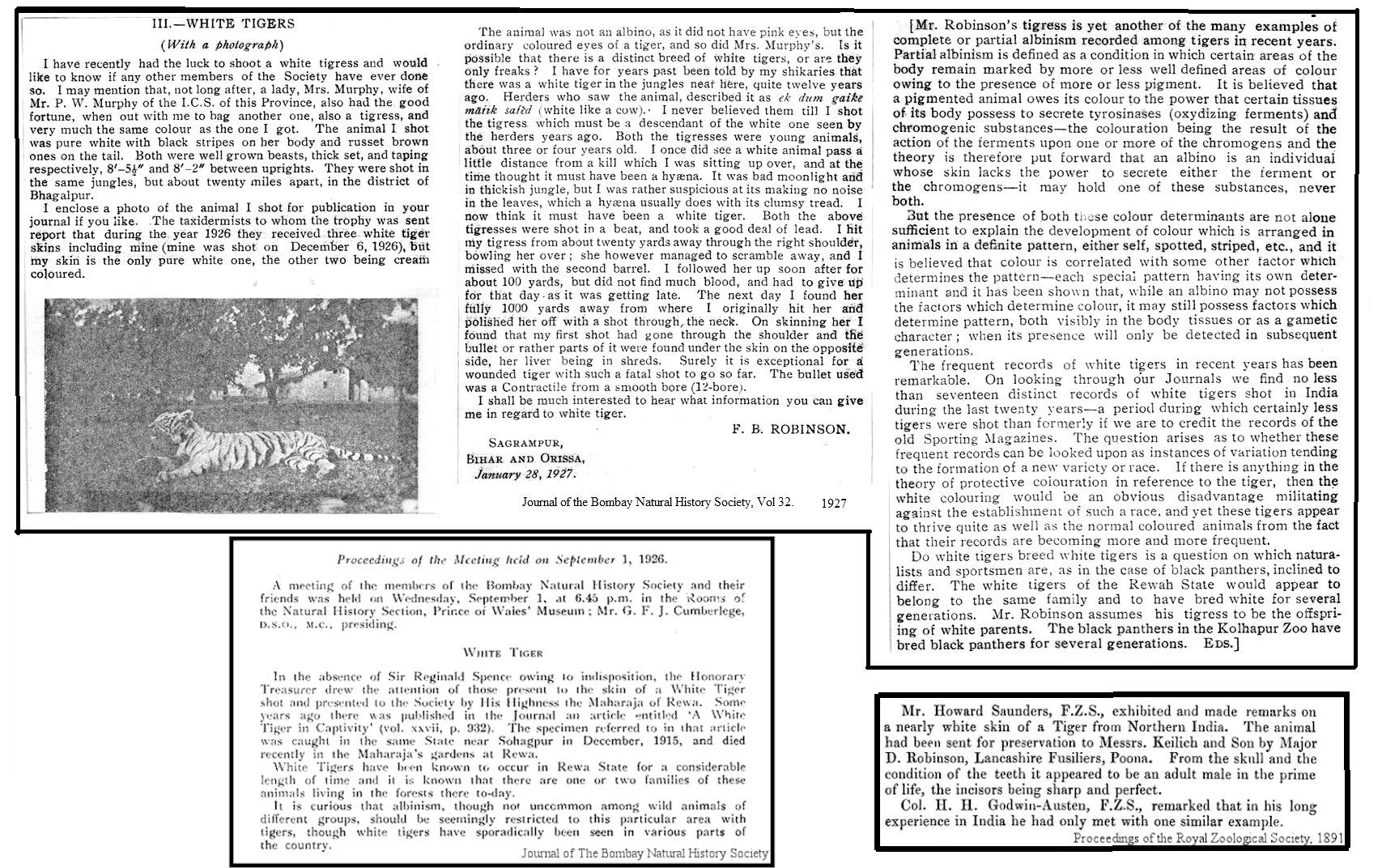
There is a newspaper clipping from 1924: “Calcutta, June 9. Sportsmen all over India are greatly interested in the skin of a white tiger recently shot by the Maharaja of Sirguja and which is now on display here. Except for a few dark stripings the pelt is almost pure white and measures nine feet eight inches from nose to tail tip. The white tiger is extremely rare, but few specimens ever having been secured, and this one is reported to have had a career of depredation that included three human victims and innumerable cattle. According to reports from the district in which it was killed, the beast actually appeared to use its unusual coloration as an aid to hunting. It was continually mistaken for a steer or cow as it lay quietly among the herds waiting a chance to kill, and the natives assert that it mixed freely with the herds without exciting alarm. Three instances are related of the tiger having been seen lying quietly in the jungle and being mistaken by natives for a beast it had slain and in each of these cases when the native approached, he was killed. “
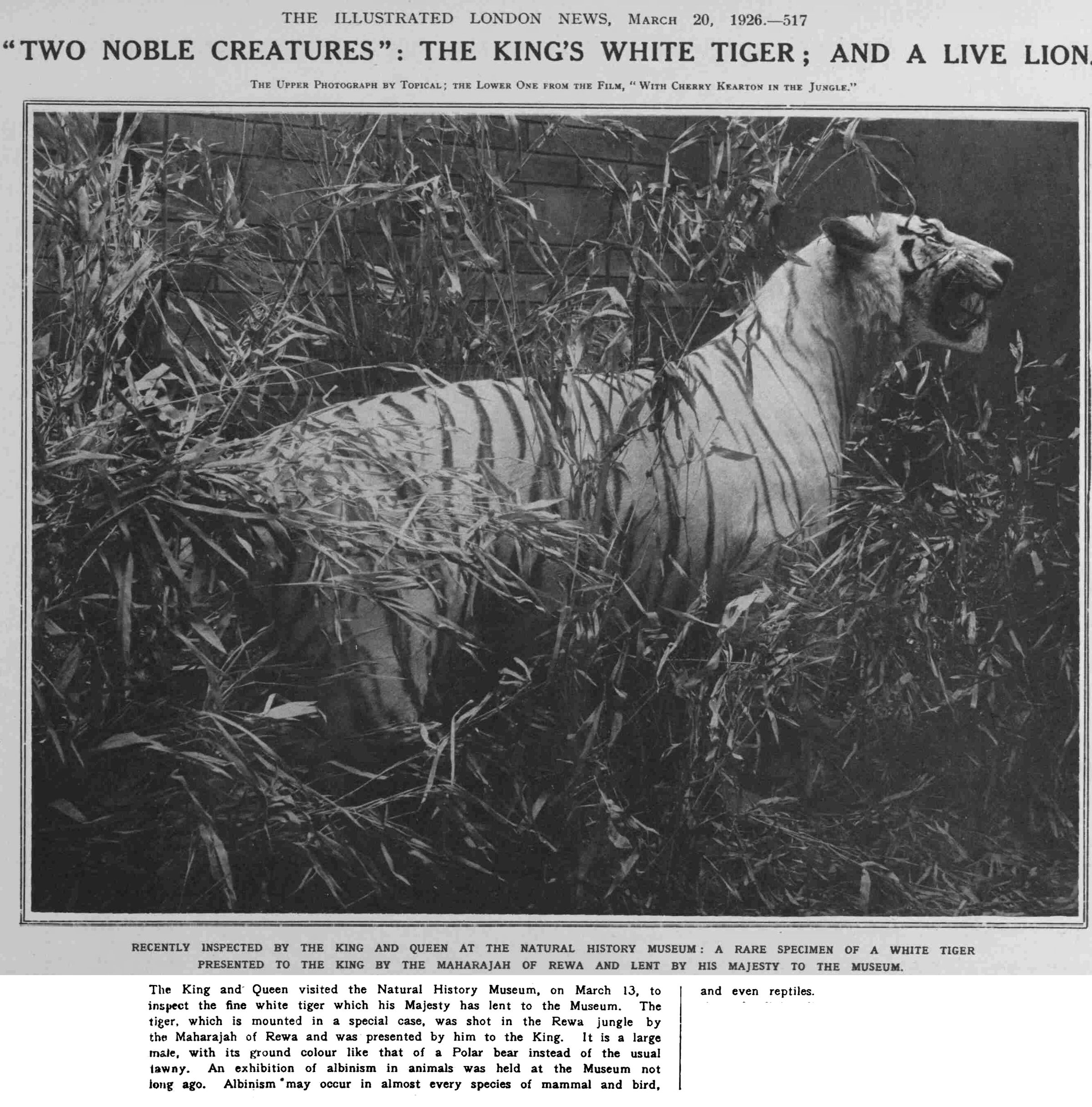
WHITE TIGERS IN INDIA, Londonderry Sentinel, 4th September 1926 - Calcutta, Thursday. - Four white tigers have been shot this summer in the province of Nagpur. The beasts have become more prevalent and menacing since the first white tiger was killed in the jungles of Central India in 1922. One of the skins is on exhibition in a Calcutta showroom. It is all white, except for a few brownish stripes on the lower part of the back. It is presumed that the albino tiger was born as a freak, later multiplying the new species through cross-breeding.
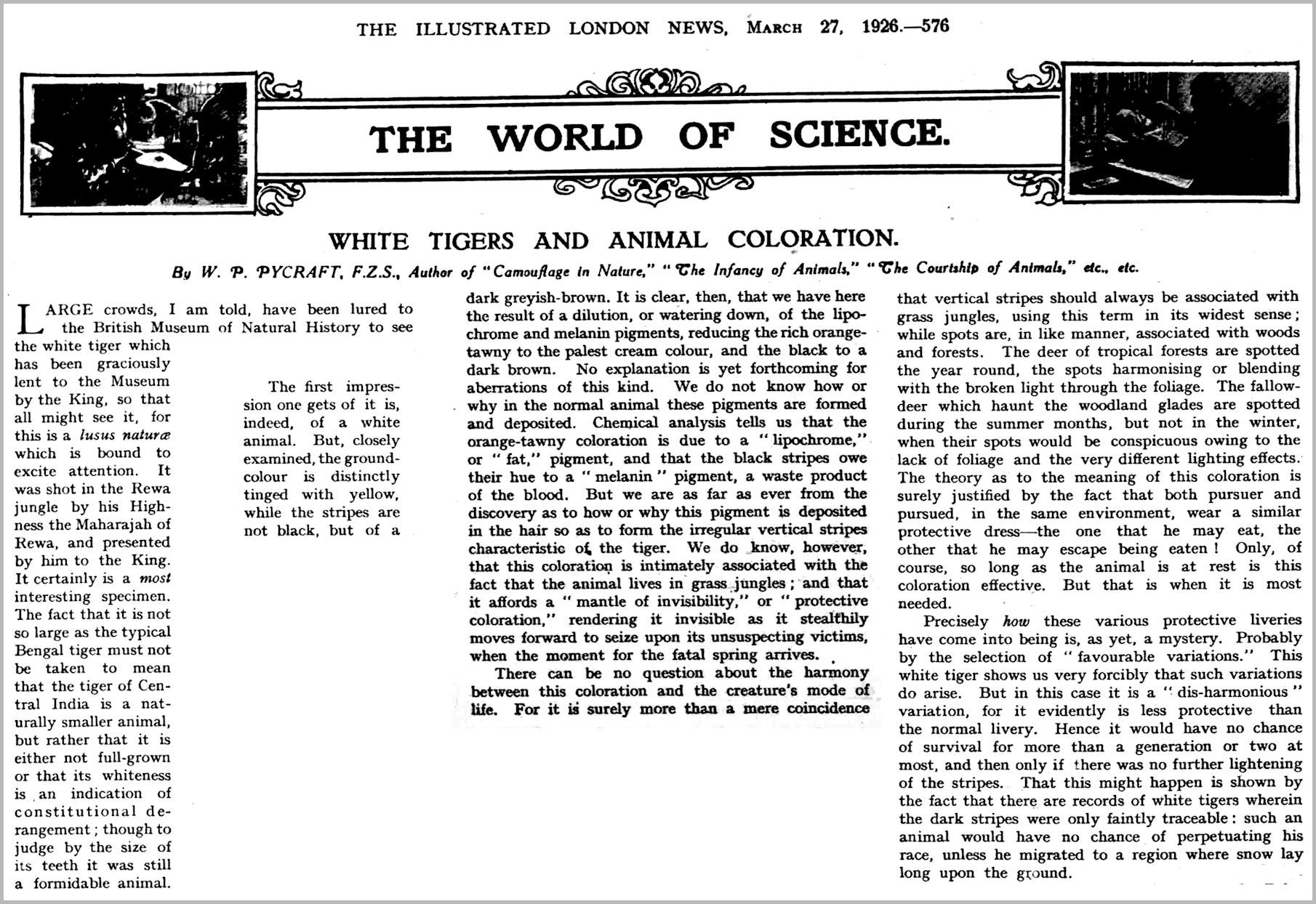
In “Sport And Wild Life In The Deccan, An Account Of Big-Game Hunting During Over Thirty Years Of Service In India, With Much Interesting Information Of The Habits Of Wild Animals Of That Country” by Brigadier-General R G Burton (1928, the authors writes: ”White tigers have not infrequently been met with, and there is a race of such albinos in the state of Rewah. One of these, captured and kept in captivity, had a pure white body, with some stripes black, but mostly ash-coloured, due to the admixture of black and white hairs. The nose was mottled grey and pink instead of the normal pink; the eyes, though not pink, showed a deficiency of pigmentation. Other specimens have been described as white with deep reddish stripes, and cream-coloured with chocolate stripes. I never heard of a white tiger in the Deccan. White tigers have been known at the head-waters of the Narbada river since about 1870, so appear to have become established as a local albino race.”
WHITE, RED AND BLACK TIGERS – RI POCOCK ((Journal, Bombay Natural Hist. Society, Vol. XXXIII, 1929)
Apart from comparatively slight individual or local variations of the normal type of colour, tigers sometimes exhibit striking variations due to suppression of pigment resulting in so-called white tigers or to development of pigment resulting in black tigers. So-called white tigers are particularly interesting from the different grades of albinism they show. Of these three types are known.
1. Tigers in which the red pigment is abstracted from the ground colour leaving it cream or white with the stripes standing out boldly in ‘ dark brown ’, ‘ chocolate ’ or ‘ reddish black ’ as observers have described. To this, the commonest, variety belong a white tigress from Orissa (Journ., Bomb. Nat. Hist. Soc., vol. xix, p. 744,1910) ; a tiger from Bilaspur (Journ., Bomb. Nat. His. Soc., vol. xxiv, p. 819, 1916); a tiger caught alive in the jungles of Sohagpur (Journ., Bomb. Not. Hist. Soc., vol. xxvii, p. 932, pi. 1921); and a few recorded from Rewa. Of these there is in the British Museum a mounted specimen deposited by H. M. King George V, to whom it was presented by the Maharajah of Rewa.
2. Like those of the first category but with the black pigment of the stripes diluted to tan. 1 am only acquainted with one example of this type, namely, a skin from Mirzapore presented to the British Museum by Mrs. Craigie Halkett. This type is intermediate between the first category and the one that follows.
3. Tigers exhibiting the extremest stage of albinism, pigment being absent not only from the ground colour but also from the stripes. Of this type I am only acquainted with one record, namely, a tiger exhibited in about 1820 in the Exeter Change and figured and described by Hamilton Smith [Note: this tiger was actually exhibited at the Tower Menagerie 1809-1811, not the Exeter ‘Change]. In this animal, the locality of which is unknown, the stripes were only visible in certain lights, as in the case of some albino tabby cats. J. G. Wood also described it, with a figure not taken from life, in the first volume of his well-known Natural History, 1861.
>Other white tigers which cannot be classified owing to absence of particulars have been recorded, namely, one, presumably from Poona, by Howard Saunders (Proc. Zool. Soc. 1891, p. 373); two tigresses from Bhagalpur, and two tigers from the Central Provinces, one being from Korea [.e. Koriya Princedom] (Rowland Ward's Records, 1928, p. 478).
[... Dressed skins in the British Museum] 4. Mirzapore.—A dressed skin of a white tiger with tan stripes, presented by Mrs. Craigie Halkett. It is just under 10 feet in length and is approximately similar in pattern to the skin from Bengal. 5. Rewa.—A mounted white tiger, with deep chocolate stripes, deposited by H. M. The King, closely resembles the last two in the extent, spacing and formation of the stripes.
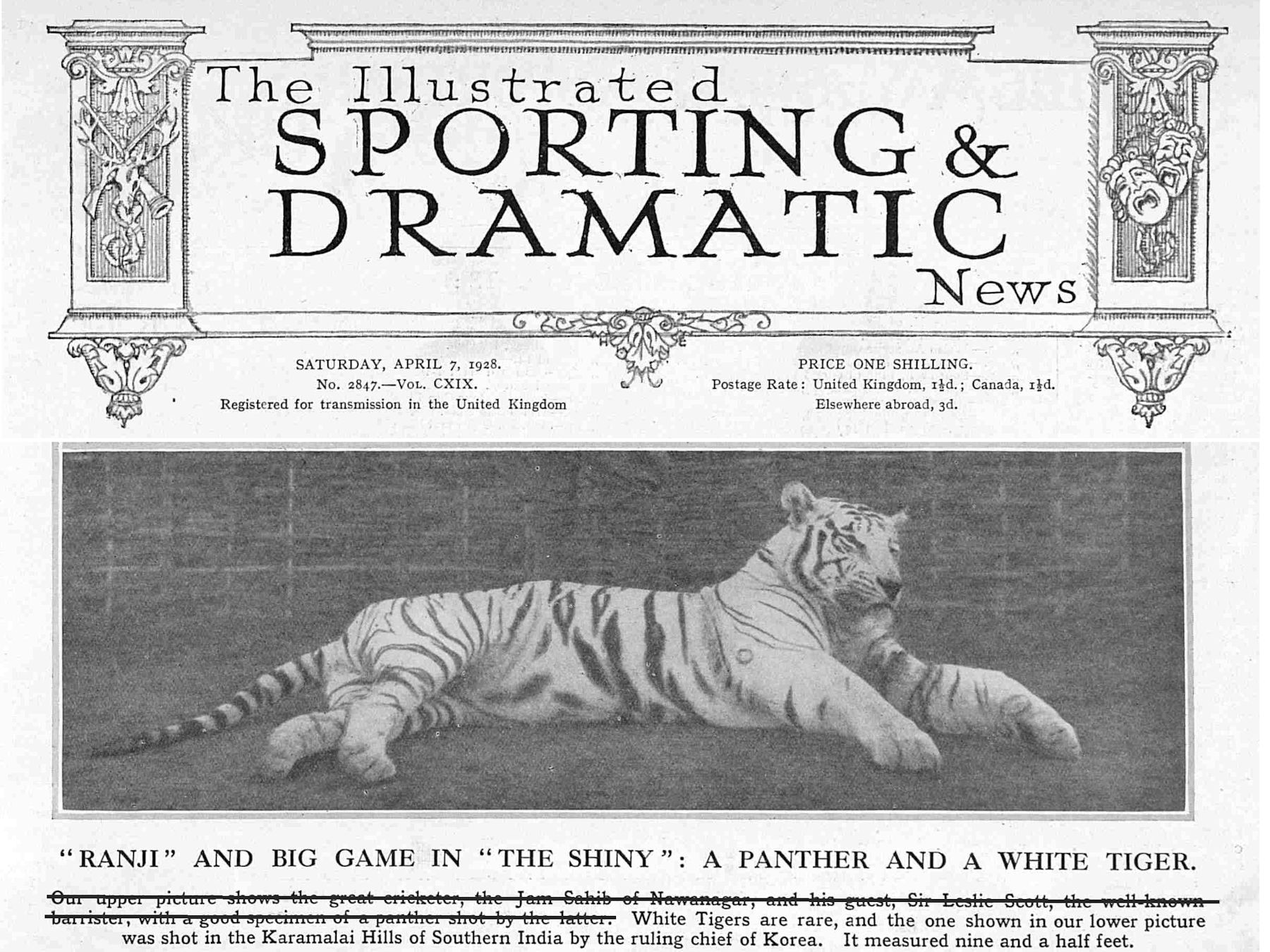
“The Ways Of Man And Beast In India“ By D. King Martin (1935): Away above us to the north rose the hill-barrier, of which the crest overlooked the Indian state of Rewah. The Prince of this State is a Baghel Rajput by descent or in other words, descended from a Sacred Tiger ; no one therefore is permitted to shoot the great cats in his realm with the exception of himself and any other chosen he may specially invite. This is probably the reason why tiger are so numerous in Bilaspur, as their breeding places are in the high hills and they come to and fro across the border. There is known to be also a special breed of white tigers in Rewah, and some years after this, while I was visiting the State on business, I was shown a magnificent living specimen in the zoo there; his fur was a very pale cream in colour against which the velvet-black stripes showed up very beautifully. The tiger was not an albino freak, for his eyes were not pink but the usual topaz yellow, and he was an altogether quite gorgeous beast and in perfect condition. Shortly before we went to Bilaspur, one of these white tigers had been shot in the jungles there; as none had been heard of before in that Division, he must have come down from over the Rewah hills.
The former Maharaja of Rewa shot a white tigress in 1937. In 1946 a pregnant white tigress was shot by the Administrator and the six unborn cubs were described as white though this was not substantiated. The Maharaja shot a white tiger in 1947, the last white tiger to be shot in the Rewa area.
The Western Morning News, 20th January 1938 reported that A fine specimen of a white tiger has been presented to the Indian Museum, Calcutta, by the Maharaja Badhadur of Gidhaur, in memory of his father who shot the animal in the Lechaur jungles of Gidhaur [Bihar region] a few years ago. “White” tigers are rare. The only records of such tigers found in India are from Orissa, Bilaspur, Sohagpur, and a few from Rewa State in Central India. In addition to slight individual or local variations in their normal skin colouration, tigers sometimes exhibit striking variations in general colour, due either to the suppression of pigment resulting in the albino or white tigers, or in the development of excessive dark pigment in black tigers. The specimen exhibited is an example of the albino type.
The film “The Maneaters of Kumaon” includes footage shot by Jim Corbett in 1938 of a wild white tiger (which seems to have a darker face) and two large orange cubs. This was filmed during his expedition to shoot man-eating tigers.
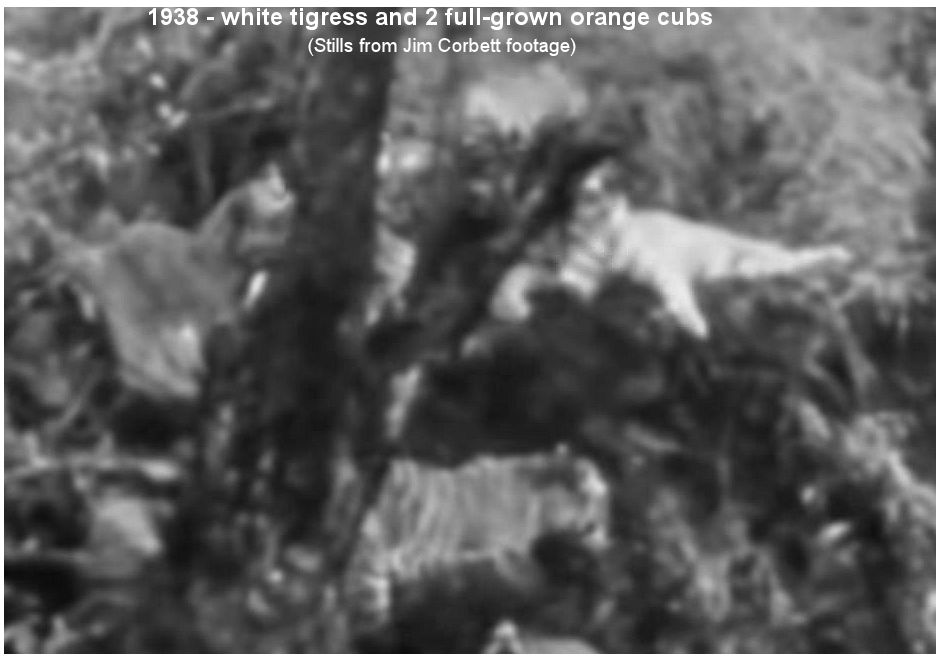
(Those 1930s white tigers probably inspired the 1938 film “Booloo” starring Colin Tapley, Jayne Regan. In the Daily Herald, 12th August, 1938, it was described as a 'jungle drama' that featured zoological close-ups of tigers, apes, snakes and other Malayan fauna. It was a “frightfully gallant story of a British officer finding a white tiger to convince some London society that his explorer father was not ‘sprucing.’ Apparently such quests are all part of English military routine.“ While the clips of animals went down well with the reviewer, the “sahib atmosphere” was described as “unconscious burlesque.” )
In the 1950s, it was believed that white tigers were found only in the drier regions (since black leopards were found in wetter regions), but they were also found in thickly forested wetter areas such as Assam and in Madhya Pradesh and Bihar (Central India), including the Bilaspur and Mandla districts of the old Central Provinces, old Rewa State, and parts of Bibar. Suggestions that these are what remains of a race of white tigers in a snowy wilderness are fanciful, especially as the mutation is seen in a tropical sub-species of tiger and tigers are a forest species! It is debatable whether white tigers have a place in the wild. They are mutant forms of the Bengal and Amur tiger and are not a sub-species. Humans have selectively bred white tigers. There are more than 600 white tigers worldwide (John Cuneo's Hawthorn Circus had more than 80) and The Zoo Outreach Organization in Tamil Nadu, India maintains a white tiger studbook compiled by AK Roychoudhury of the Bose Institute in Calcutta.
In July 1955, a white tigress was reportedly seen in the jungles of Vindhya Pradesh, Central India, but was never shot or captured; she was fancifully claimed to be the mate of the Maharaja or Rewa's white tiger. “White Tigress Worth Fortune to Capturer” (Corpus Christi Caller Times, 18th June 1955): “New Delhi. The world’s only known white tigress is roaming the bamboo jungles of Vindhya Pradesh in central India, worth a fortune to anyone who can trap it alive. The tigress is believed to be the mate of a rare white tiger, captured by the Maharaja of Rewa two years ago and now kept in captivity in the maharaja’s palace. It was sighted by forest guards recently, but efforts to trap it so far have failed. An American buyer is reported to have offered $92,000 for the male white tiger now in the maharaja’s palace. Because of the rarity of the animal, the Indian government refused to allow its export. The white tigers are not a new breed. They are simply albinos, and wild life experts believe it may be possible to breed a race of albino tigers from them. The young maharaja already has tried mating his white tiger with an ordinary one. It fathered three cubs, but all turned out to be yellow. If the white female could be caught, she could be mated with one of the cubs fathered by the white male, with some hope of producing a white cub. Albinos mated with albinos do not produce albino cubs, but cross-breeding may produce results.” [This report contains errors – albinos mated to each other always produce albino cubs and a white fmale mated to the maharaja’s white male would have produced 100% white offspring; the white tiger was believed at that time to be an albino.] This report also appeared as “Riches Await Trapper Of White Tigress” in the Los Angeles Times, 31st July 31, 1955 (p 57).
The last recorded wild white tiger was shot at Bihar in 1958. It was shot near Hazaribagh in Bihar, and the skin displayed at a Calcutta taxidermist’s establishment. Although they are no longer seen in the wild, the mutant gene may still be in the gene pool. The Boga-bagh (White Tiger) Tea Estate in upper Assam is so called from the two white tigers shot there at the beginning of the 1900s; one of them had "a lemon-coloured patch on the back of the neck, otherwise it was white with faint stripes". Two light-coloured tigers shot by WG Forbes of Hathikuli Tea Estate in 1929 were described at the time of curing by Messrs. Van Ingen as "red tigers" (i.e. light coloured with light brown stripes).
White tigers have been recorded outside of the Indian state of Rewa and as far afield as China and Korea and from Nepal, Burma, the Malay Peninsula, Sumatra, and Java. (“A Chinese Bestiary - Strange Creatures from the Guideways Through Mountains And Seas” (Richard E. Strassberg) “Two hundred twenty li farther west is the Mountain Where Bird and Rat Share a Hole. On its heights are many white tigers and much white jade.) The surprise occurrence of white tigers in American Zoos suggests that several orange Bengal tigers imported from India may have carried the recessive white gene. The only identified carrier was the Bengal tigress Susie who came from an unidentified West coast zoo, and who was a descendant of Mohan of Rewa via one of his heterozygous offspring sold to an animal dealer (information known to her buyers). Susie introduced the white gene into Amur/Siberian crosses.
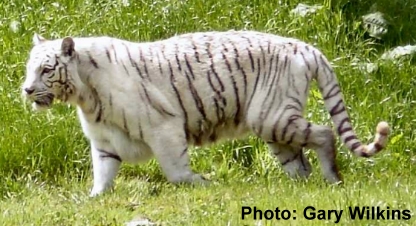
According to KS Sankhala, "Ever since white tigers were discovered, people have been fascinated by them, and scientific opinion has differed as to whether they are a separate race, complete or partial albinos, or merely mutants." One of the earliest records of white tigers is of one displayed in London in 1820 and described by Rev J G Woods as "a creamy white, with the ordinary tigerine stripes so faintly marked that they were only visible in certain lights". White tigers were routinely shot between 1892 and 1922 in places such as Orissa, Upper Assam, Bilaspur, Cooch Behar and Poona. Pollock (1900) reported white tigers from Burma and the Jynteah hills of Meghalaya, Between the 1920s and 1930s fifteen white tigers were killed in the Bihar region and more were shot in other regions. Some of the trophies exhibited in Calcutta Museum. In 1922, two pure white young adult tigers with pink eyes were shot in Cooch Behar (north-east India). At Mica Camp, Tisri in Behar. On 22 January 1939, the Prime Minister of Nepal shot a white tiger at Barda camp in Terai Nepal. In 1951, a normal coloured tigress and cubs were shot, but her white cub was captured alive some days later. This cub "Mohan" ("Enchanter") became the founding father of the white tiger breed. The last observed wild white tiger was shot in 1958 and the mutation is considered extinct in the wild. The slaughter of hundreds of orange tigers evidently killed the carriers of the mutant gene.
"...north China has produced a number of albinos, with the inevitable but faint brown stripe. Very rare melanistic (black) tigers are known." ("King Of Cats And His Court by Victor H. Cahalane, National Geographic Feb. 1943)
There was a chair upholstered with white tiger skin in the collection of Marjorie Merriweather Post; a colour photo of which appeared in an article titled "Mrs. Post's Magnificent World" published in "Life" magazine (Vol 59, No 19, Nov 5, 1965).
In 2017, a pale-furred "white" tiger was spotted for the first time in the Nilgiris Biosphere Reserve in 2017 by a wildlife photographer. Its brother was also "white", though its mother and sister had normal coats. Neither of those animals were 100% white. They were pale, with coats much lighter than the usual orange base colour. It was believed by wildlife experts that their colouration was due to reduced levels of melanin causing a condition called “leucism,” meaning they were not true white tigers ("cream tigers"?).
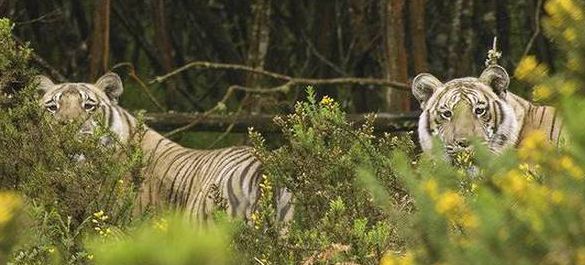
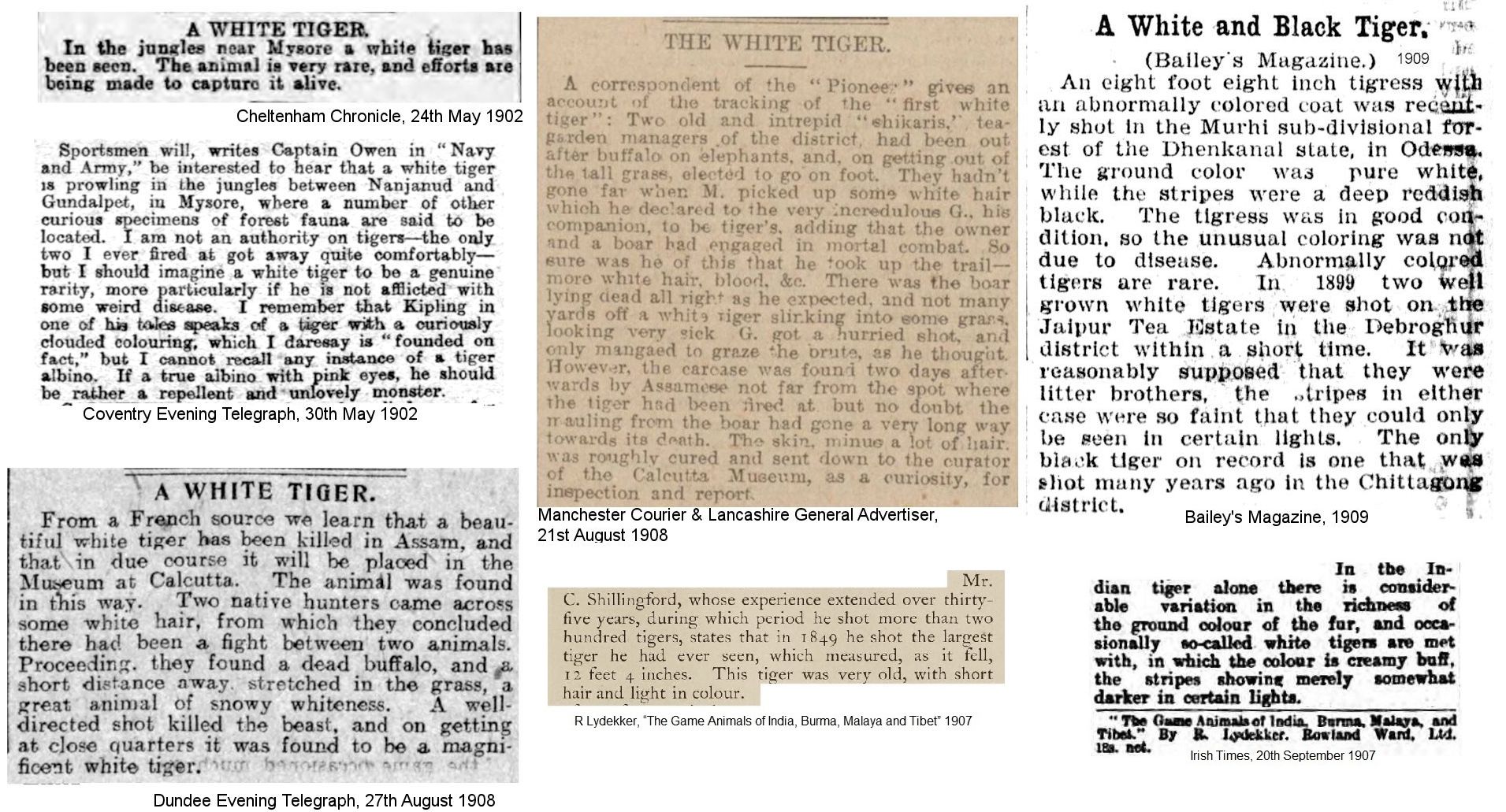
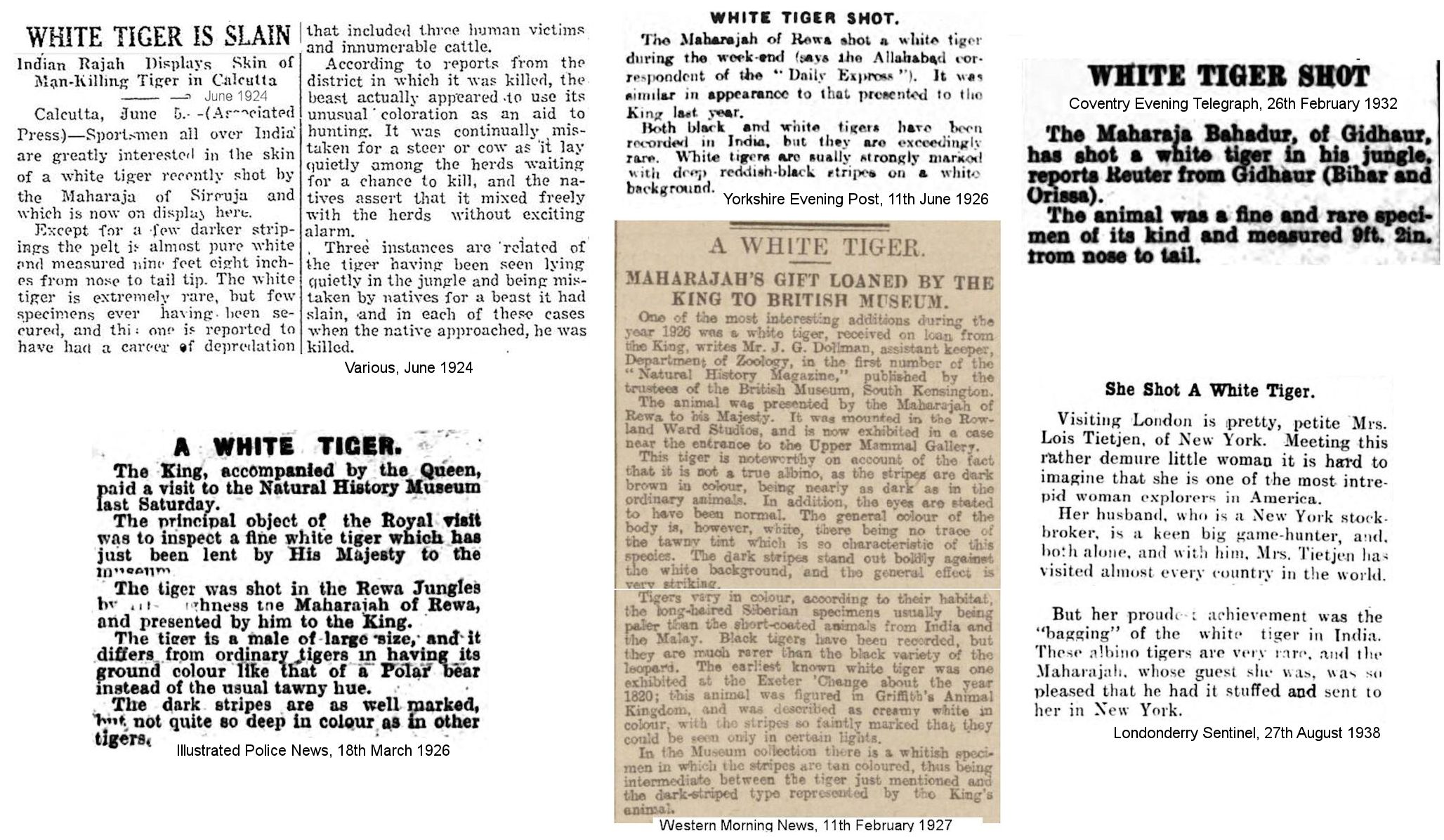
Textual content is licensed under the GFDL.
Albino tigers (Cooch Behar)
Narayan, V. N. 1924. Number of cubs in a tiger’s litter. J. Bombay Nat. Hist. Soc., 28:1124.
Pocock RI, 1939. Fauna of British India, including Ceylon and Burma. Mammalia, vol. 1. Primates and Carnivora. Taylor and Francis Ltd., London, 464 pp.
White tigers (Orissa, Bilaspur, Rewa, Bhagalpoore, North Bengal, Assam and Korea)
Cuvier, Georges. 1832. The Animal Kingdom. G. & C. & H. Carvill.
D'Abreu EA. 1916. An Albino Tiger From The Central Provinces JBNHS, Vol XXIV, Pt IV, pg 819
Dunbar Brander AA. 1923. Wild Animals In Central India.
Evans Gordon (Capt). 1921. A White Tiger In Captivity (With A Photo). JBNHS, Vol. XXVII, Pt IV, pg. 932
Gee, E. P. 1959. Albinism and partial albinism in tigers. JBNHS., 56:581-587.
Lydekker, Richard. 1893. The Royal Natural History. Frederick Warne.
Mishra, Swati Wilderness Diagnosis, 2001: What Is the White Bengal Tiger's Future? Action BioScience.
Pant, M. M. & Dhariyal, I. D. (1979) : White tiger progeny, its economic potentialities. Indian Forester. Special issue on 1st International Symposium on tiger. New Delhi, 22nd-24th Feb. pp. 52-58.
Pocock RI, 1929. Tigers. J. Bombay Nat. Hist. Soc., 33:505-541.
Pocock RI, 1939. Fauna of British India, including Ceylon and Burma. Mammalia, vol. 1. Primates and Carnivora. Taylor and Francis Ltd., London, 464 pp.
Rathore, B. S. & Khera, S. S. (1979): Mortality in tigers in India. Paper presented in 1st International Symposium on tiger. New Delhi.
Roychoudhury, a. K. & Sankala, S. K. (1979) : Inbreeding in white tigers. Proc. Indian Acad, Sci. 8SB: 311-313.
Roychoudhury, A. K. (1980) : Is there any lethal gene in the tiger of Rewa? Curr. Sci. 49: 518-520.
Saharia, V. B. (1979) : Population dynamics in captive tigers. Wildlife News letter 7: 36-40.
Thornton, I. W. B., K. K. Yeung, and K. S. Sankhala. 1967. The genetics of the white tigers of Rewa. J. Zool. (London), 152:127-135.
Weigel, I. 1961. Das Fellmuster der wildlebenden Katzenarten und der Hauskatze in vergleichender und stammesgeschichtlicher Hinsicht. Säugetierk. Mitt., 9 (Sonderheft):1-120.
Genetics of Chinchilla and Albino
Robinson's Genetics for Cat Breeders & Veterinarians 4th Ed (the current version)FOOTNOTE
Most white tiger websites have a pro- or anti-agenda and variously claim to give “facts,” “truths” or debunk “myths” but give misinformation or have hidden agendas. I stick to facts and deductions based on facts. Some information is documented, some is from personal correspondence with zoos, and some is from the recollections or personal notes of people involved with circus or zoo tigers where records were have been lost or destroyed. Even the different editions of tiger studbooks are inconsistent. Information from my pages, which are frequently updated, is widely copied on those other sites. Some sites have tried to claim I copied their work.
|
BACK TO HYBRID & MUTANT BIG CATS INDEX |